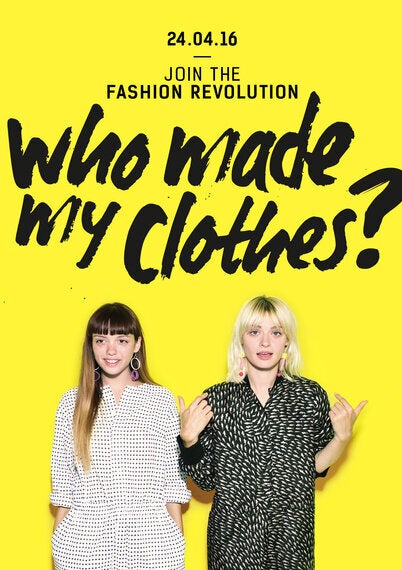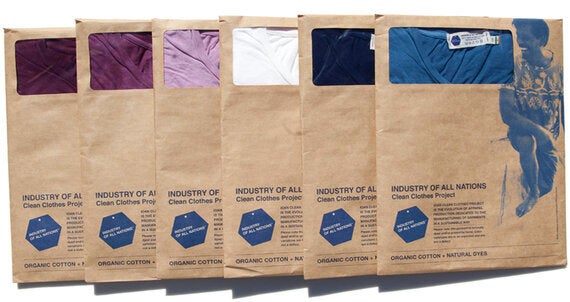The millennial generation, oh so coveted by marketers, is the primary driving force behind the go-green revolution. From food to consumer products, companies must adopt the values of sustainability, transparency, and authenticity if they're going to engage the next generation of buyers. But when it comes to clothing, consumers across all demographics have yet to demand sustainability and transparency on a large scale--what gives?
The conscious fashion movement faces more complex challenges than the organic food movement, including an extreme lack of information about apparel supply chains. And unlike food, there's no explicit connection in consumers' minds about clothing and health, or even the people behind the clothes, which include farmers, fiber processors, dyers, tanners, and factory workers.

Fashion Revolution's conscious consumer campaign engages millennials and young consumers of fashion. Credit: Fashion Revolution
Dara O'Rourke, founder of GoodGuide and newest addition to Amazon's sustainability "dream team," says that most people are still in a "pre-awareness phase" when it comes to sustainable and ethical fashion.
"Most people don't have any idea that their clothing is often coated with chemicals that may have a significant impact on human health and the environment," O'Rourke says in a recent report on transforming the apparel industry from Ashoka and C&A Foundation. "And it was only through the tragedy of Rana Plaza that many people even looked at their garments and asked 'Where are they from?'"
The sweatshop outrage of the '90s didn't translate into real change, but today, the conscious fashion movement is starting to up its game. Here are three fresh tactics that are inspiring consumers, and particularly millennials, to drive a transformation of the industry:
Leveraging the "Prius Effect" and Social Influences
Sustainable clothing often comes at higher prices, but ethical clothing companies are starting to become more effective at combining sustainable values with smart branding. When brands place sustainability at the core of their identity and marketing, conscious customers can outwardly express their values through the clothes they wear.
"We've learned over the years through GoodGuide and other research that presenting scientific information about labor, environmental conditions, and apparel supply chains has quite a limited impact on mainstream consumers," says O'Rourke. "But things like peer influence have incredibly powerful influences on consumers. Understanding social norms and social influence are critical for really transforming consumer awareness and actual behavior change."
"Social norms are how people think of themselves, what they aspire to be like, and how they expect others to act. As for social influence, people are constantly watching other people, and the biggest predictor of purchases is people like you driving that car, wearing that jacket, or holding that phone."
A promising direction for the conscious fashion movement is combining sophisticated marketing with the work of NGOs pressuring companies toward transparency--that is, allowing activism and buying to work together. O'Rourke believes that fashion, which is "by nature a form of conspicuous consumption," is ripe for mining "the Prius effect"--"People see you driving around in a Prius, and it gives you recognition as a person who is thoughtful about environmental or energy issues. People see you in your Patagonia jacket, and the choice of your clothing similarly signals and creates the potential for status and for the social influence effect. "
Patagonia actively encourages its customers to buy less and reuse and repair more, which memorably markets the quality of its products and imbues the consumers wearing the label with cultural cachet. As another example, H&M's "Conscious Collection" has a distinct green tag that communicates explicitly consumers' "Conscious" status to fellow shoppers.

Image via Unsplash
Creating Positive Emotions, Not Guilt
A recent psychological study found that shaming consumers for buying unethical clothing doesn't work-it makes them not only averse to shopping sustainably, but they tend to go out of their way to insult those that do shop sustainably.
Instead, highly visible campaigns like Fashion Revolution focus on empowering consumers with a voice to talk back to brands and making sustainability cool. Fashion Revolution began as a hashtag campaign, a "call to arms" that engaged consumers to ask brands on Twitter #WhoMadeMyClothes? On the 2015 anniversary of Rana Plaza catastrophe, the hashtag trended globally at number one on Twitter with 64 million users.
By encouraging consumers to post selfies, Fashion Revolution effectively taps into millennials' behavior patterns on social media, as well as the fashion demographic's innate interest in self-expression. Coupled with dynamic visual branding, the campaign creates a positive sense of empowerment to act. According to co-founder Carry Somers, brands interpreted each #WhoMadeMyClothes tweet as representative of 10,000 other customers who felt the same.
A number of boutique sustainable fashion labels, like Industry of All Nations (IOAN) and Bureo, are also creating positive emotions through authenticity-oriented branding. IOAN emphasizes "clean" clothing (made with materials like naturally dyed organic cotton and undyed alpaca fiber) and extensively documents its production process and the communities behind them.
Bureo, which makes sunglasses (as well as skateboards) out of recycled fishing nets, draws an explicit connection between its customers and protecting oceans from plastic waste. "We aim to engage the modern consumer by delivering high-quality sustainable products that fuse environmental consciousness with the adventuresome spirit of outdoor enthusiasts," Bureo co-founder David Stover says. "Our approach is an inclusive one that empowers our customers to be a part of the movement for cleaner oceans. Our target market is looking for more than just a story behind a brand - we believe they are responding to mission-based brands that connect their values to products with environmental traceability."

Industry of All Nations packages its Clean Clothes Project T-shirts with sustainability information printed on the outside. Image via Industry of All Nations
Be Transparent-Even if Results Aren't Perfect
Apparel value chains are incredibly complex. "At the moment, most brands can't answer the question #whomademyclothes," Carry Somers says, citing Behind the Barcode's recent findings that "48% of brands hadn't traced the factories where their garments were made, 75% didn't know where their fabrics came from, and 91% didn't know where the raw materials came from."
Dara O'Rourke, however, notes that there are large brands and retailers who are working behind the scenes to become sustainable so that they can be well-positioned once the market begins to demand it. "They are trying to figure out how to get ahead of these trends and often quietly doing a lot, because they don't want to be a target of criticism for when they fall short or when their goals are not ambitious enough," O'Rourke says. "There are very few brands that are strong enough to come out in the way that Patagonia does to say, 'Here's the good and here's the ugly. Here's what we're working on, and here's what we haven't gotten right yet.'"
While brands may be loathe to place themselves in the crosshairs of an unflattering exposé, they might take a page from the playbook of the original sweatshop pariah, Nike. Amidst reports of child labor and workers earning as little as 14 cents an hour, CEO Phil Knight eventually addressed the public, saying, "The Nike product has become synonymous with slave wages, forced overtime and arbitrary abuse. I truly believe that the American consumer does not want to buy products made in abusive conditions." By admitting to the problem and pledging to pursue transparency and improvements, Nike was able to shed its nasty image and is now a favorite with millennials.
Engaging in "radical transparency" like successful fashion startup Everlane has the potential to build trust with millennial consumers and turn them into partners for doing better. The company includes factory and base cost information for each of its products. On its mission page, Everlane writes, "We know our customers are also rule breakers and questioners, so we hope this philosophy is palpable in the products and choices we make. And by all means, challenge us too."
When Will Fashion Finally Tip Toward Sustainability?
It's important to note that while consumers drive the bottom line, they can't vote with their wallets without the right information. A key challenge for the conscious fashion movement remains the lack of transparency that continues to be pervasive in the majority of apparel supply chains.
There is hope, however, with the Sustainable Apparel Coalition's Higg Index, which is helping brands like Target, H&M, and prAna, assess their sustainability from raw materials down to product disposal. Perhaps in the near future, Higg scores will find their way to clothing labels and make it easier for consumers to shop according to their values.
There remains a significant tension, however, between consumers' need for clear and easily accessible information about sustainability and the potential for greenwashing by brands. For example, critics have pointed out that certification labels, especially those that use benchmarks created by brands, don't always tell customers the full story. A broader question is, how can the sustainable fashion movement push brands to set high standards for sustainability, while also recognizing incremental change, rather than taking an all-or-nothing approach?
Fashion Revolution is also working on a Transparency Index with Ethical Consumer that will rank major brands. Look out for the Transparency Index to be published in April 2016, when Fashion Revolution will host a week of events, including the #WhoMadeMyClothes campaign.
This post was written by Kristie Wang (@kristiewang) for Ashoka Changemakers and Fabric of Change, an initiative that supports solutions for building a fair and sustainable apparel industry.